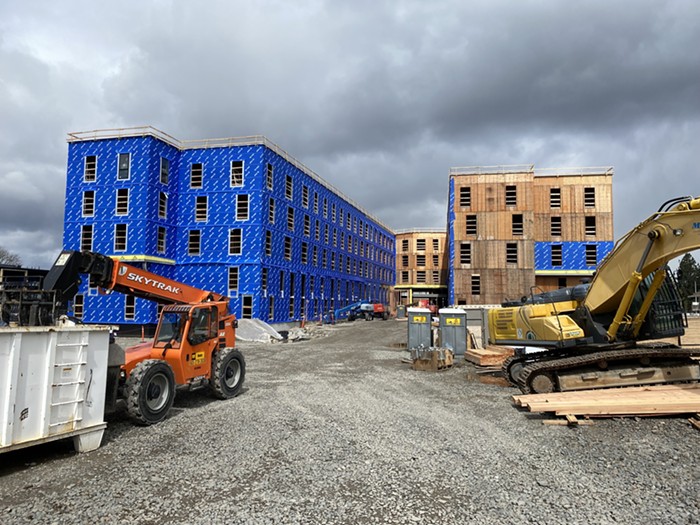MAYOR TED WHEELER had a change of heart on Valentine’s Day.
At its meeting that morning, the Portland City Council was set to hear a report on the city’s signature anti-gentrification gambit—a groundbreaking policy that gives preference for affordable housing and housing loans in historically Black neighborhoods to those who have been displaced from the area.
The report was to be delivered by members of the committee keeping watch over the policy, known as the “N/NE Neighborhood Housing Strategy.” Their draft report [PDF] , published online ahead of the hearing, suggested the group had less than stellar news to impart.
But Wheeler, the city’s housing commissioner, canceled at the last minute.
“Rather than having the Housing Bureau and the oversight committee and our nonprofit partners potentially pointing fingers,” the mayor said at the time, “what I want us to do is meet and come to a consensus on how to address the concerns laid out in the report.”
The report will now come before council in March, but that’s no reason not to talk about those “concerns.” Years into its experiment, the city has been largely unsuccessful in helping former residents of North and Northeast Portland come back as homeowners.
Since the experimental housing strategy passed in early 2015, the oversight committee reports, just four households have been able to purchase homes using city loans of up to $100,000 for down payments. (Housing officials say a fifth household was scheduled to close on a home on February 28.) In 2015, the Portland Housing Bureau’s five-year goal for creating homeownership through those loans was 40 households.
“To date we have made little progress,” says the oversight committee’s report, calling the finding a “significant concern.”

It’s not the only issue the committee raised. The report mentions a decreasing number of loans to help existing residents of the area repair their homes (only 18 were granted in 2017, compared to 40 in 2016), suggests housing officials haven’t provided “timely information” to the committee, and worries that affordable housing isn’t being added quickly enough in the 4,000-acre area covered by the strategy.
As a result of these misgivings, Wheeler is calling a huddle, and housing officials are retooling their calculations. “I’ve instructed PHB to come up with a specific set of action items to address the oversight committee’s concerns,” the mayor said on February 14.
This year’s report is notable for its difference in tone from past reports, which were more upbeat.
“We ran into some challenges in the last year,” says Bishop Steven Holt, who chairs the committee. “We are making sure promises made are promises kept.”
The promises he refers to were made nearly four years ago, when a city-backed proposal to build a Trader Joe’s at the corner of Northeast MLK and Alberta sparked intense backlash. Community activists were outraged the city would welcome a grocery store that could contribute to displacement, rather than building cheap housing to help people remain in the neighborhood.
The controversy ultimately spooked Trader Joe’s. More importantly, it led to a commitment from then-Mayor Charlie Hales and Commissioner Dan Saltzman, who pledged $20 million to pay for housing initiatives the city’s historically Black neighborhoods (roughly $90 million more has since been added to the effort, according to the PHB).

Hales and Saltzman promised more than just cash. The politicians sought community input on how to use the money, which resulted in a detailed strategy involving loans for down payments, money for new affordable housing complexes, funds to help people repair their homes, and more.
Far more groundbreaking, though, was the “preference policy” the city came up with. It established a process that gives priority to people who were pushed out of inner North and Northeast Portland in past decades—an injustice that especially affected Black Portlanders. Under the plan, highest preference for housing or financial support goes to those who can show that their families were forced to move in the wave of displacement that occurred to make way for Memorial Coliseum, Interstate 5, and Legacy Emanuel Medical Center. Those who’d been forced to leave for other reasons also get a leg up.
The preference policy “has the opportunity to set the pace for the nation,” the newly released report says. But so far, it hasn’t done much.
The Oregonian reported in 2016 that an early effort to sell tiny condos via the policy didn’t attract interest. And the fast-rising real estate market has meant the city has had to repeatedly raise the amount it’s willing to loan for down payments—from an initial proposal of $60,000 to $100,000.
It hasn’t worked.
According to city figures, 52 households have been approved for down payment loans under the preference policy—but just five of those have actually been able to purchase a home. The reasons are partly due to the way the city decided to implement the policy, according to Shannon Callahan, the housing bureau’s interim director

“We’ve chosen to prioritize folks who do have some barriers and challenges,” says Callahan, . Unlike other PHB programs, she says, the city didn’t screen applicants based on their income or readiness to own a home under the preference policy. “That has definitely made a difference.”
Despite this slow progress, supporters argue it’s too early to write off Portland’s preference policy. “The policy itself is fantastic,” says Holt, the chair of the oversight committee. “The implementation has had challenges.”
City officials promise that results are coming. A large chunk of the plan focuses on making affordable apartments available to people who were pushed out. But while there are hundreds of units in development, the first won’t be available until later this year.
And Callahan says there’s still hope for creating new homeowners under the policy, even if they’re not buying the single-family homes that have become wildly expensive in the neighborhoods targeted under the plan. There are currently two condominium developments in the works that will be available to preference policy applicants.
That’s not to say change isn’t necessary. Callahan says the city is taking a fresh look at how it screens applicants for loans under the policy, and whether to forgive those loans completely if a homeowner lives on their property for decades. She plans to have answers on hand when the policy comes back up before city council once again later this month.
“This has taken longer than we all initially anticipated,” Callahan says. “I think we understand why. I think we also need an action plan to explain where we’re going.”
















